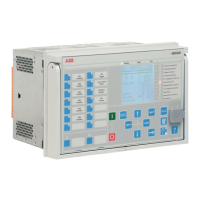as the fault moment on the voltage wave, fault location, fault resistance and the
parameters of the feeders and the supplying transformers. In the fault initiation,
the voltage of the faulty phase decreases and the corresponding capacitance is
discharged to earth (→ discharge transients). At the same time, the voltages of
the healthy phases increase and the related capacitances are charged (→ charge
transient).
If the fault is permanent (non-transient) in nature, only the initial fault transient
in current and voltage can be measured, whereas the intermittent fault creates
repetitive transients.
Figure 211: Example of earth-fault transients, including discharge and charge
transient components, when a permanent fault occurs in a 20 kV network in phase C
4.2.3.6 Signals
Table 427: INTRPTEF Input signals
Name Type Default Description
Io SIGNAL 0 Residual current
Uo SIGNAL 0 Residual voltage
BLOCK BOOLEAN 0=False Block signal for activating the
blocking mode
Table 428: INTRPTEF Output signals
Name Type Description
OPERATE BOOLEAN Operate
START BOOLEAN Start
BLK_EF BOOLEAN Block signal for EF to indicate op-
posite direction peaks
Protection functions 1MRS757644 H
426 620 series
Technical Manual

